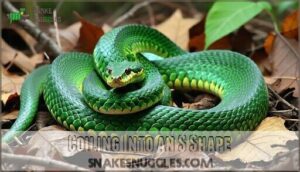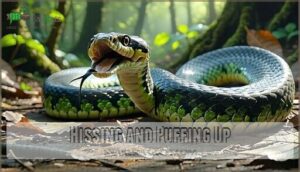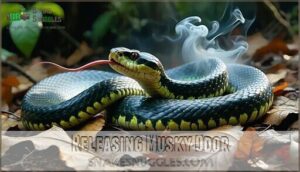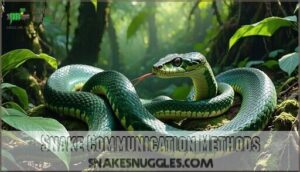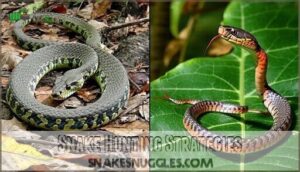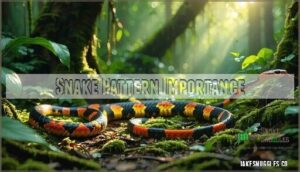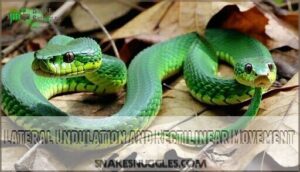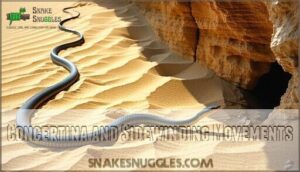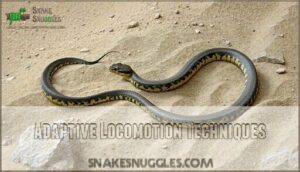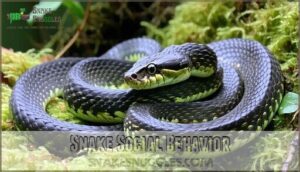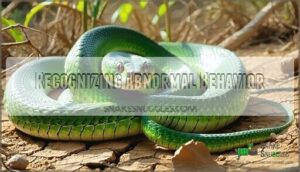This site is supported by our readers. We may earn a commission, at no cost to you, if you purchase through links.
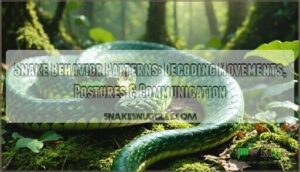 You’ll notice snake behavior patterns reveal fascinating insights into their survival strategies.
You’ll notice snake behavior patterns reveal fascinating insights into their survival strategies.
They’re masters of body language, using everything from tail vibrations to musky odors for communication.
Their hunting styles vary dramatically – some ambush prey while others actively stalk, and even their colorful patterns serve multiple purposes, from camouflage to warning signals.
Understanding these behavioral cues helps you interpret what a snake’s really "saying" through its movements and postures, including tongue flicking to gather chemical information, head movements that signal threats or curiosity, and distinctive coiling postures when defensive.
Table Of Contents
- Key Takeaways
- Snake Behavior Patterns
- Defensive Snake Postures
- Snake Communication Methods
- Snake Hunting Strategies
- Snake Pattern Importance
- Types of Snake Patterns
- Snake Movement and Locomotion
- Snake Social Behavior
- Snake Health and Wellness
- Recognizing Abnormal Behavior
- Frequently Asked Questions (FAQs)
- What are the behaviors of snakes?
- How can you tell when a snake is happy?
- What are the 4 types of snake movement?
- How to tell if a snake is aggressive?
- What are snake behavior patterns?
- Why are snake patterns important?
- What is a guide to snake behavior?
- How do you know if a snake is aggressive?
- What are the different types of snake patterns?
- What patterns do snakes have?
- Conclusion
Key Takeaways
- You’ll decode your snake’s "language" through tongue flicking patterns – slow flicks mean they’re exploring, while rapid flicks signal hunting mode or stress
- Watch for defensive warning signs before they escalate – S-shaped coiling, hissing, and musky odors are your cues to back away immediately
- Your snake’s patterns aren’t just pretty decorations – they’re survival tools for camouflage, temperature control, and warning potential threats
- Movement styles reveal hunting strategies and health status – active foragers constantly search while ambush predators stay motionless, and changes in normal locomotion can indicate problems
Snake Behavior Patterns
You’ll find that snakes communicate through fascinating body language that’s surprisingly easy to decode once you know what to look for.
Their tongue flicking, head movements, and posture changes reveal everything from curiosity to stress, helping you understand their current mood and needs.
Tongue Flicking Behavior
Tongue flicking acts like nature’s chemical radar system, letting snakes detect scent particles through their vomeronasal organ.
Nature’s chemical compass guides snakes through their world with invisible precision.
You’ll notice different patterns reveal specific behaviors:
- Slow, deliberate flicks: Environmental exploration and calm investigation
- Rapid, frequent flicks: Prey location and hunting mode activated
- Oscillatory movements: Pheromone reception and chemical cues analysis
- Yawning function: Enhanced scent particle detection through air sampling
This process relies on the Jacobson’s Organ function for analysis.
Head Wiggling and Movement
Your snake’s head wiggling serves as a Curiosity Indicator when exploring new environments or investigating potential prey.
However, constant or jerky head wiggling can signal Stress Signals or Health Concerns like neurological issues.
Movement Analysis reveals that normal snake movement includes deliberate head positioning, while abnormal patterns during slithering motion suggest problems.
Environmental enrichment can reduce stress-related head wiggling.
Species Variation affects typical snake locomotion patterns, so understanding your snake’s normal serpentine gait helps identify concerning changes in behavior.
Eye Color Changes and Shedding
Looking beyond head movements, you’ll notice your snake’s eyes become cloudy or blue-gray during the shedding process. This eye opacity signals the blue phase, when vision becomes impaired and your snake feels vulnerable.
Watch for these shedding cycle indicators:
- Opaque eyes appear milky or cloudy blue
- Increased defensive behavior and hiding
- Reduced appetite during eye color changes
- Shedding frequency varies by age and species
- Retained spectacle risks if humidity stays low
Understanding these snake behavior patterns helps you recognize normal shedding problems versus health concerns. This cloudiness is often due to the snake’s eyes regenerating a new layer of skin, but you should monitor them for retained eye caps.
Defensive Snake Postures
When snakes feel threatened, they’ll switch into defense mode with three distinct warning signals.
You’ll see them coil into an S-shape for striking, puff up while hissing to appear larger, or release a foul musky scent to discourage predators.
Coiling Into an S Shape
When you see an S-shape coiling, that’s your cue to back away slowly.
This defensive posture signals maximum strike readiness, with muscles tensed for rapid threat assessment and energy expenditure.
Understanding these snake behavior patterns helps you recognize defensive postures before danger escalates.
| Behavior Aspect | Description |
|---|---|
| Muscle Tension | Coiled muscles store energy for lightning-fast strikes |
| Strike Readiness | Head positioned for ideal striking angle and distance |
| Threat Assessment | Snake evaluates escape routes while maintaining coiling position |
| Evolutionary Advantage | S-shape coiling maximizes defensive capability with minimal movement |
Hissing and Puffing Up
Beyond coiling, hissing and puffing up represent powerful defensive postures in snake behavior patterns. These audible deterrents and defensive inflation tactics create an intimidating threat display through body enlargement and respiratory control.
When you encounter this behavior, you’re witnessing threat mimicry—the snake’s attempt to appear larger and more dangerous than it actually is.
Here are five key aspects of this defensive behavior:
- Sound Production: Hissing occurs when air rapidly escapes through the glottis, creating a warning sound
- Visual Intimidation: Puffing inflates the body to appear twice the normal size
- Energy Conservation: This bluff costs less energy than actual combat or escape
- Species Variation: Some snakes flatten their necks while others expand their entire torso
- Warning Sequence: Hissing typically precedes striking, giving you time to retreat safely
Releasing Musky Odor
When threatened, snakes release a foul-smelling glandular secretion that acts like nature’s pepper spray.
Nature’s pepper spray warning: back off or face the stench of survival.
This musky odor contains complex compounds designed to confuse and repel attackers, giving the snake precious seconds to escape.
- Scent persistence: The powerful musk can linger for hours, creating a lasting deterrent that warns other predators to stay away.
This defensive mechanism triggers an immediate predator response, as most animals instinctively avoid anything that smells like decay or danger.
Snake Communication Methods
You’ll discover that snakes communicate through a fascinating combination of body language, chemical signals, and tail movements that reveal their intentions and emotional states.
These silent conversations happen constantly in the snake world, from territorial warnings to mating invitations, all without making a single sound, which is a remarkable example of silent conversations.
Body Language and Posture
Through careful observation, you’ll decode snake body language like reading an open book.
Their postures reveal intentions—Defensive Coiling in S-shape formations signals strike readiness, while Relaxed Postures with loose coils indicate contentment.
Stress Indicators include constant head movement and rigid positioning.
Threat Displays involve hissing and puffing up to appear larger.
Watch for Mimicry Signals when harmless species copy dangerous ones.
Posture Meaning Example
Chemical Signals and Pheromones
Snakes reveal a hidden world through chemical signaling that you can’t see but they can’t live without.
Pheromones create invisible scent trails that deliver vital mating signals and territory marking messages.
Using their Jacobsons organ and olfactory sense, they decode these pheromone trails like reading a newspaper.
Males follow female scent paths during breeding season, while chemical defense compounds warn competitors away.
This scent communication system orchestrates everything from reproduction to survival in their silent world.
Tail Movements and Vibrations
When you see rapid tail vibrations, you’re witnessing nature’s clever alarm system.
Non-venomous species shake their tails against leaves, creating rattling sounds that mimic dangerous rattlesnakes—it’s vibration mimicry at its finest.
These tail signals serve as defensive deterrents, warning predators to back away.
Species variation affects intensity and frequency, with some snakes producing subtle movements while others create dramatic displays.
Understanding these tail movements helps you decode snake communication and recognize defensive postures before they escalate into strikes.
Snake Hunting Strategies
You’ll observe two primary hunting strategies when studying snake behavior: ambush predators that rely on perfect camouflage and lightning-fast strikes, and active foragers that continuously search for prey using their keen senses.
These distinct approaches reflect millions of years of evolution, with each species developing hunting methods perfectly matched to their habitat and prey preferences.
Ambush and Stealth Tactics
Master hunters wait motionlessly for hours, relying on camouflage effectiveness to remain invisible.
You’ll find these patient predators positioned near water sources or game trails, where prey detection becomes effortless.
Their stealth tactics involve controlled breathing and minimal movement while monitoring sensory input.
Habitat influence determines positioning success, as timber rattlesnakes blend perfectly against fallen logs.
When prey approaches, strike precision delivers lightning-fast attacks.
- Perfect concealment: Blending seamlessly with surrounding vegetation and debris
- Strategic positioning: Selecting high-traffic areas where unsuspecting prey travels regularly
- Motionless patience: Remaining completely still for extended periods without movement
- Lightning strikes: Delivering precise, rapid attacks when prey ventures within range
Active Foraging and Stalking
Unlike ambush hunters, active foraging snakes constantly move through their territory, using prey detection through scent trails and vibrations.
You’ll notice their stalking techniques involve methodical ground coverage and frequent tongue flicking for sensory input.
This snake hunting strategy requires higher energetic costs but increases hunting success in prey-rich environments where stealth tactics alone won’t suffice.
Constriction and Subduing Prey
Constriction behavior transforms your typical snake hunting into a deadly embrace.
You’ll witness these predators wrap muscular coils around prey, applying coil pressure that stops blood flow within seconds. Through heartbeat detection, snakes know exactly when to release their grip, making prey suffocation swift and efficient.
Key constriction facts you should know:
- Pressure precision – Snakes apply 5-250kPa of force, enough to cause cardiac arrest in minutes
- Energy investment – Constriction increases metabolic rate sevenfold, making reptile challenges particularly costly
- Smart sensing – Boas feel prey’s heartbeat and adjust pressure accordingly during prey detection
- Jaw flexibility – After constriction, specialized jaw structures allow swallowing prey whole during snake feeding
Snake Pattern Importance
You’ll discover that snake patterns aren’t just beautiful decorations – they’re sophisticated survival tools that help these reptiles avoid predators, regulate their body temperature, and warn potential threats.
Each stripe, band, spot, and solid color serves a specific purpose, from the perfect camouflage of a timber rattlesnake’s bands to the bright warning colors that scream "danger" to would-be attackers, utilizing sophisticated survival tools and displaying bright warning colors.
Camouflage and Predator Evasion
You’ll discover that snake camouflage works like nature’s ultimate invisibility cloak.
Blending strategies include pattern disruption through stripes that confuse predators about movement speed and direction.
Behavioral camouflage involves freezing completely when threatened, enhancing their natural reptile camouflage.
Mimicry tactics help harmless species copy dangerous ones – think milk snakes imitating coral snakes.
Banded patterns create visual confusion, while spotted designs provide versatile concealment across different terrains.
These sensory evasion techniques and defensive postures represent millions of years of evolutionary refinement, turning predator evasion into an art form that keeps snakes alive.
Thermoregulation and Habitat Adaptation
Snake patterns aren’t just for show—they’re survival tools. Your snake’s coloration helps regulate Habitat Temperature through Basking Behavior. Dark patterns absorb heat faster, while lighter ones reflect it.
Thermoregulation drives Seasonal Changes and Nocturnal Activity patterns based on Regional Adaptations.
- Desert snakes use light colors to prevent overheating
- Forest species display darker patterns for heat absorption
- Environmental factors determine daily activity schedules
- Cold-climate snakes bask longer than tropical species
- Habitat selection directly influences pattern evolution
To guarantee their well-being, consider proper temperature gradients.
Warning Signals and Venom Indicators
You’ll spot at least five warning signals when a snake means business—think bold coloration warnings, dramatic hood displays, or tail rattling that mimics venomous species.
These are classic venom indicators and defensive mechanisms, not party tricks.
Spitting accuracy and threat response, like hissing or aggressive postures, all say, “Back off!”
Venomous mimicry helps even harmless snakes avoid trouble. Respect these cues—they’re nature’s way of keeping everyone safe.
Types of Snake Patterns
You’ll notice that snake patterns aren’t just for show—they’re sophisticated survival tools that determine how each species hunts, hides, and handles threats.
Understanding whether you’re looking at stripes, bands, spots, or solid colors reveals essential information about that snake’s behavior and lifestyle, including how it hunts.
Striped and Banded Patterns
You’ll notice how striped patterns create a stripes speed advantage through disruptive coloration—predators can’t track their movement accurately.
Meanwhile, banded patterns excel at banding camouflage, letting snakes disappear against logs or rocks.
Pattern mimicry shows evolutionary pressures at work, as harmless species copy dangerous ones.
These visual patterns in snake camouflage represent millions of years of survival innovation.
Spotted and Blotched Patterns
When hunting for camouflage versatility, you’ll find spotted and blotched patterns excel at habitat specificity.
These snake patterns create optical illusions that enhance predator avoidance through pattern evolution’s genetic basis.
- Spotted patterns blur during movement, making snakes nearly invisible against dappled forest floors
Snake camouflage with blotched patterns works like nature’s perfect puzzle pieces.
Each spot breaks up the snake’s outline, confusing predators who can’t distinguish between shadow and serpent.
These patterns exemplify evolutionary adaptation.
Snake coloration evolved specifically for survival advantage.
Solid Coloration and Patternless Snakes
Unlike patterned relatives, solid coloration provides you with remarkable camouflage effectiveness when habitat matching is perfect.
These patternless snakes excel at predator evasion by blending seamlessly into uniform environments like sandy deserts or leafy canopies.
Hunting advantages emerge from their stealth—prey can’t spot movement patterns.
Color mutations in snake coloration demonstrate nature’s efficiency, proving that sometimes less truly is more for snake camouflage.
Snake Movement and Locomotion
You’ll discover that snakes move through four distinct methods, each perfectly adapted to their environment and hunting needs.
These locomotion patterns reveal fascinating insights into how these limbless predators navigate everything from desert sand to tree branches with remarkable efficiency.
They are able to do this because their movements are adapted to their specific environments.
Lateral Undulation and Rectilinear Movement
When you watch a snake move, you’re seeing lateral undulation in action—the classic S-shaped waves pushing against surface friction.
Muscular contraction creates these rhythmic curves, while rectilinear movement lets snakes inch forward straight.
Speed variation depends on terrain and prey needs.
This snake locomotion showcases evolutionary advantages across diverse habitats, making snake movement perfectly suited to their environment through specialized snake anatomy.
Concertina and Sidewinding Movements
When tight spaces or slippery terrain challenge a snake’s movement, concertina locomotion and sidewinding mechanics become essential.
Concertina movement uses body sections as anchors—snakes grip with one part while stretching or compressing the rest. Sidewinding conquers loose surfaces like sand by lifting body sections diagonally, preventing sinking.
These specialized techniques showcase snake behavioral ecology’s remarkable adaptability, allowing efficient navigation across diverse habitats where lateral undulation fails.
- Surface friction determines which locomotion method snakes choose for ideal energy expenditure
- Concertina movement excels in narrow tunnels and vertical surfaces requiring precise grip control
- Sidewinding mechanics create distinctive S-shaped tracks while minimizing contact with hot sand
- Habitat influence shapes snake movement patterns, with desert species mastering sidewinding techniques
- Energy expenditure varies substantially between movement types, influencing hunting and escape strategies
Adaptive Locomotion Techniques
You’ll find snakes mastering diverse terrains through remarkable adaptive locomotion techniques.
They seamlessly switch between lateral undulation, concertina movement, and sidewinding based on surface conditions.
Arboreal locomotion enables tree-climbing through body wrapping, while aquatic adaptation powers swimming efficiency.
Subterranean movement navigates tight burrows, and gliding snakes achieve aerial maneuvers.
This speed and efficiency optimization across environments showcases incredible snake adaptation and versatile snake movements.
Snake Social Behavior
You might think snakes are loners, but they’ve got some surprising social secrets that’ll change how you see these fascinating creatures.
From elaborate courtship dances to recognizing family members, snake social behavior is far more complex than most people realize.
Solitary and Social Species
Most snakes live alone, but Social Snake Myths don’t tell the whole story. You’ll find fascinating Cooperative Behaviors in certain snake species that challenge solitary behavior expectations.
Garter snakes demonstrate remarkable Snake Aggregation during hibernation, while some species show Communal Nesting patterns. These behavioral adaptations reveal complex social behavior beyond typical snake behavior assumptions.
Snakes also use chemical cues for social interactions.
Key snake species social interactions include:
- Group Hunting strategies in rare cases
- Shared basking sites for thermoregulation
- Communal den sites during winter months
- Scent recognition among familiar individuals
- Cooperative defense against predators
Mating and Courtship Rituals
When breeding season arrives, you’ll notice male snakes following pheromone trails left by females, sometimes traveling remarkable distances.
Courtship displays include rhythmic jerking motions and tail movements that signal interest.
Males engage in fascinating combat dances, wrestling and intertwining to establish mating rights.
These mating rituals demonstrate complex social behavior, where reproductive success depends on reading chemical signals correctly.
Some species create dramatic mating balls with multiple males competing for one female.
Family Bonds and Recognition
Beyond mating rituals, you’ll discover something remarkable: snakes actually recognize family members.
Timber rattlesnakes use pheromones to identify siblings, staying twice as close to relatives than strangers. This kin recognition shapes their social behavior through chemical cues and genetic similarity.
Mothers in species like pythons provide parental care, guarding nests and defending young.
- Sibling bonds: Related rattlesnakes cluster together at shared dens for years
- Chemical recognition: Snakes identify family through scent, even after separation
- Protective instincts: Mother snakes risk their lives defending offspring from predators
Snake Health and Wellness
You’ll notice healthy snakes display predictable patterns in their daily routines, from basking schedules to feeding responses.
Understanding these wellness indicators helps you recognize when your snake’s behavior signals good health versus potential problems that need attention, which can be critical for maintaining your snake’s overall health.
Thermoregulation and Metabolic Function
Think of ectothermic regulation as your snake’s daily survival strategy.
You’ll see them seek basking behavior when their metabolic rate drops, choosing perfect spots based on temperature preference.
Smart habitat selection keeps them alive—warm rocks for energy, cool shade when overheated.
During winter, snake brumation kicks in, slowing metabolism dramatically.
Their thermoregulation system works like a biological thermostat, constantly adjusting to maintain life.
To guarantee proper temperature control, consider using a reptile habitat controller.
Shedding and Skin Health
Through shedding cycles, snakes replace worn scales via the ecdysis process. You’ll notice opaque eyes and dull skin signaling upcoming snake shedding.
Retained shed can cause scale damage or skin infections, requiring immediate attention. Proper humidity prevents complications during shedding frequency changes.
Many owners also find shedding assistance products helpful.
- Monitor shedding frequency patterns
- Increase humidity during ecdysis process
- Check for retained shed pieces
- Prevent skin infections through cleanliness
- Watch for scale damage signs
Hibernation and Brumation Patterns
After healthy shedding comes winter’s slowdown. Snake hibernation isn’t true hibernation – it’s brumation.
Brumation triggers include dropping temperatures and shorter days. Metabolic slowdown reduces energy needs by up to 70%. Den selection matters – snakes choose spots below frost lines.
Regional variations affect timing, while emergence cues include warming temperatures and prey availability.
| Brumation Aspect | Details |
|---|---|
| Duration | September-April depending on climate |
| Metabolic Rate | Decreases 47-70% from normal levels |
| Temperature Tolerance | Must stay above freezing in dens |
Recognizing Abnormal Behavior
You’ll spot abnormal snake behavior when your pet acts differently from its usual patterns, which often signals health issues or environmental stress.
Understanding these changes helps you provide better care and catch potential problems before they become serious, by recognizing abnormal snake behavior.
Neurological Problems and Stress
When you observe erratic movement, disorientation, or unusual behavioral changes, your snake might be experiencing neurological problems or snake stress.
These neurological signs can stem from infections, trauma, or nutritional deficiencies, while captivity stressors like poor husbandry trigger aggressive behavior and abnormal behavior.
Watch for these stress indicators:
- Stargazing posture with twisted head positioning
- Loss of coordination and righting reflex
- Head tremors or seizures
- Regurgitation combined with weight loss
- Persistent striking or defensive posturing
Environmental enrichment and proper care reduce these issues substantially.
Environmental Factors and Adaptation
Environmental changes can make or break your snake’s well-being. Temperature swings, humidity shifts, and Habitat Influence disrupt natural snake behavior patterns.
Your pet’s survival strategies depend on stable conditions for proper thermoregulation and environmental adaptation. To maintain these conditions, consider using a terrarium temperature regulator.
Watch for these Climate Impact signs:
- Erratic movement patterns during Seasonal Changes
- Reduced hunting activity when Prey Availability drops
- Stress responses triggered by Evolutionary Pressures in captivity.
Monitor habitat conditions closely.
Aggressive Behavior and Defensive Postures
While environmental stresses can trigger unusual behaviors, snake aggression and defensive postures serve as survival mechanisms.
When you spot these warning signs, you’re witnessing natural protective instincts.
| Behavior | Description | Response |
|---|---|---|
| Strike Readiness | S-shaped coiling with raised head | Back away slowly |
| Hood Spreading | Flattened neck, enlarged appearance | Avoid sudden movements |
| Musk Release | Foul-smelling secretion | Give snake space |
| Feigning Death | Rolling over, mouth open | Don’t handle or disturb |
Recognizing snake defense mechanisms like tail mimicry helps you identify stressed animals.
Snake behavior changes when threatened—hissing, puffing up, or defensive behaviors signal danger.
Understanding snake postures keeps both you and the snake safe during encounters.
Frequently Asked Questions (FAQs)
What are the behaviors of snakes?
You’ll find snakes constantly flicking their tongues like tiny taste-testers, gathering scent particles to navigate their world.
They communicate through body language—coiling into S-shapes when threatened, vibrating tails, and hissing to intimidate predators while using clever camouflage patterns for hunting success.
How can you tell when a snake is happy?
You’ll spot a relaxed snake lounging in loose coils with a soft body, flicking its tongue slowly to explore surroundings rather than rapidly searching for threats or food.
What are the 4 types of snake movement?
You’ll see four distinct snake movement patterns: serpentine (side-to-side undulation), rectilinear (straight-line belly crawling), concertina (accordion-like bunching), and sidewinding (diagonal rolling motion across sand).
How to tell if a snake is aggressive?
Watch for these key warning signs: coiled S-shape posture with head drawn back, hissing sounds, puffed-up body, and rapid tail vibrations. You’ll also notice intense staring and defensive positioning.
What are snake behavior patterns?
Like a snake’s ancient dance, you’ll observe deliberate patterns that reveal their inner world. They communicate through tongue flicking, body positioning, and defensive coiling, each movement telling their survival story.
Why are snake patterns important?
Snake patterns serve as survival tools that help you identify their behavior and potential danger.
These visual features provide camouflage, temperature regulation, predator warnings, and indicate hunting strategies specific to their environment.
What is a guide to snake behavior?
Understanding snake behavior patterns can literally reveal the secrets of the natural world.
You’ll observe their defensive postures, hunting strategies, and communication methods through body language, tongue flicking, and visual displays to facilitate safe interactions.
How do you know if a snake is aggressive?
You’ll spot aggressive snakes through defensive coiling into S-shapes, hissing, puffing up their bodies, tail vibrations, and releasing musky odors. These warning signals mean back away immediately.
What are the different types of snake patterns?
Picture patterns as nature’s paintbrush on scales—you’ll spot four main types.
Uniform colors are for active hunters, while stripes are for speedy escapes.
Bands or blotches are characteristic of ambush predators, and spots are for versatile camouflage in varied environments.
What patterns do snakes have?
You’ll spot four main snake patterns: uniform colors, stripes, bands or blotches, and spots.
Each pattern serves specific survival purposes like camouflage, hunting strategies, and predator deterrence through mimicry or intimidation displays, including camouflage.
Conclusion
Like a master linguist speaking without words, you’ve deciphered the secrets of snake behavior patterns that make these reptiles fascinating survivors.
Understanding their tongue flicking, defensive coiling, and chemical communication helps you read their intentions accurately.
You’ll recognize when they’re hunting, threatened, or simply exploring their environment.
Their colorful patterns aren’t just decoration—they’re survival tools for camouflage and warning signals.
By interpreting these snake behavior patterns, you’ll appreciate how these remarkable creatures navigate their world through movement, posture, and ancient instincts.
- https://en.wikipedia.org/wiki/Rectilinear_locomotion
- https://www.britannica.com/animal/snake/Specializations-for-securing-food
- https://phys.org/news/2018-03-reveals-snakes-strategies.html
- https://californiaherps.com/behavior/snakelifehistorydefense.html
- https://www.oriannesociety.org/faces-of-the-forest/snake-patterns-and-behaviors/


